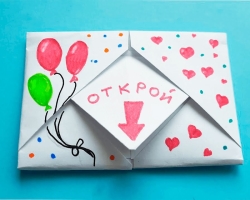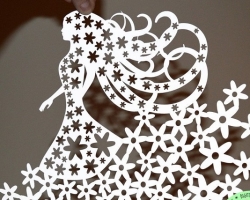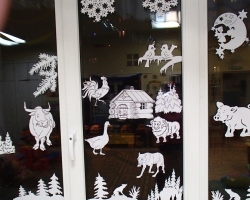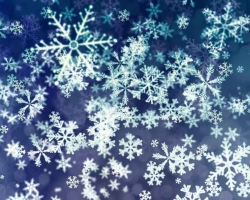At first glance, it may seem that such a hobby for modern needlewomen as felting appeared relatively recently.
Content
However, what do you say that about 8000 years ago, people already put into practice the manufacture of various things from wool? Later, entire workshops specializing in working with natural hair began to appear. Let's see where everyone can get acquainted with this needlework today.
Felting for beginners: Master class
It is too early to immediately make toys or paintings to beginner needlewomen. But something simple like jewelry is quite possible. Let's try to do it flower brooch.
So, for the brooches "lily of the valley" you will need:
- Actually, wool
- Thin felting needles
- Thin wire
Important: it is recommended to use the wire that is used for weaving products from beads, that is, 0.4 millimeters.
- Thick sponge or brush as a stand for the manufacture of jewelry
- PVA
- Beads with a diameter of 7-10 millimeters
- Acrylic varnish
- Scissors
- Soapy water
- Fastener used to make brooches

We proceed:
- Primarily, it is necessary to form a frame for leaves. And for this you will need a wire

- Now a strand of green wool is taken. It must be put under the frame and on the brush. This strand is needed pierce with needles
Important: keep in mind that the strand should be larger than the wire frame. You should not take it back.
- The strand is turning over, actions from the previous paragraph are repeated

- The ends of the impromptu leaves wrap

- The workpiece was obtained under the leaf. Now you need it put the wire frame again

- The edges of the leaf are also processed Using felting needles
- Now is the time to give the leaves of naturalness, shitting it with wool Green Gamma
Important: in order for the transitions of the shades to turn out to be smooth, it is worth smooth the workpiece with an iron.
- Further The outlines of the sheet are formed - He should not be flat, because it is unnatural. In this case, the twisted ends of the wire stick out from the workpiece
- Glue is applied to the above twisted ends of the wire. A little more green wool should be applied to glue. Wool is twisted Thus, so that the wire is not visible at all, and the stem is formed. You need to help yourself with a needle

- Now you can start the manufacture of twigs. Take a little white wool and form a kind of pancake from it
- In such a pancake and you need to put the bead, decorating it then with wool. For the best effect, you should help yourself with needles
- Now the bead should be lowered into soapy water, and then roll out in your hands
Important: it is worth removing knocked out wools with scissors.
- One top is cut off, after which 8 incisions are made. The bead is taken out of the woolen cocoon - and now the woolen workpiece reminds of the outlines of the flowers of the valley
- Received flowers need to mate in acrylic varnish. However, the varnish should first dilute the varnish with water. The blanks are squeezed, dried
- Bunks are formed -white-green woolen balls
- Well, now the assembly begins - Balls are strung on the wire. The wire is twisted so that the balls do not separate from it
- Also flowers are strung, and from a piece of wire sticking out of a flower core
- All branches are collected, fastened together with green wool and glue


- Now a twig, leaflet and hairpin for brooches are gathering together. You can decorate this product with a green ribbon
The next jewelry - bright summer beads in felting technique. For them come in handy:
- Wool. As for the color scheme, it can be the most diverse
Important: Pay attention to that you have wool, not acrylic.
- Needle. It is advisable to purchase a rough ordinary felting needle
- Waxed cord. Stock up 2-3 meters
- Hats for beads or acorns. If you have not found sturges near yourself, you can contact the accessories store
- Special felting brush. However, you can replace it with a regular sponge for washing dishes or a piece of foam
- A variety of accessories - These are holders for pendants called Bailey, and locks and fasteners for cords. However, if you can’t get it all, there is an option to use a waxed cord or a chain from some unnecessary decoration

We start work:
- So, first of all, Take wool. Fluff it, confuse it with your fingers
Important: how much material is needed for one bead? It all depends on the size of the beads, but in any case, in any case, that the wool is very sat down during operation. This means that the supply is necessary.

- Wool is twisted into the ball. You need to make more efforts, since the wool should be twisted tightly

- Put the ball on the stand - brush, sponge or foam. Do not forget to hold the ball with your fingers, since at this stage it may well fall apart. In him the needle is stuck To fix the form, and you need to start from the place of fastening the wool

- Now need to process the entire surface of the ball with a needle - So it falls better, becomes denser and better in shape


- A similar procedure carried out with other balls for beads

- It is recommended to complete the process of wool wool. pour hot water into a bowl, dissolving a shampoo or liquid soap in it. Balls are thrown into this bowl
Important: Before lowering all the balls, you should make sure that the wool will not divert. Otherwise, there is a great risk of obtaining a spotted product.

- Each ball gets and rolls between the palms As if you are working with plasticine, that is, in a circle. At first, the pressure should be weak, but then it should be increased. If you immediately crush, ugly creases may form. Do not be surprised if the dimensions decrease to 30% or even 50%

- As soon as the bead becomes denser and smaller, it rolls between the palms as a sausage. This action needs to be carried out until the bead it will resemble an egg

- Beads should be rinsed In order to remove the soap solution. Then they need to be squeezed and put to dry

- And at this stage you need process the assembled sturges. You must first separate the hats, then from the hats - tails. Holes are made in the hats. These details are thoroughly washed and dried. You can, if desired, process the blanks for beads varnish
Important: if you purchase special hats for beads, then the stage with drilling holes, of course, is not needed.

- A piece is cut off from the waxed cord, folds in half and tied with a loop

- Now the task is more complicated - pull the loop through the cap. If she does not want to extend in any way, you can resort to a little cunning, namely, pass a thread through a hat, hook a loop with a thread, and then put it all into a hat

- Pull the loop so that the knot rests on the hat. Another knot is tied from the inside of the hat so that the loop does not move anywhere

- At the bottom of the impromptu hat should be added a small amount of glue

- Now to glue busin is pressed
Important: you need to press the bead strongly, but not for long - a few seconds are enough.

- The final stage - putting on all loops with beads on some unnecessary chain or on a waxed cord

Materials and tools for felting from wool
Important: no matter what technique is used, the materials are needed the same.
- So, first of all, this is special unexplored wool. Density, stiffness and color have no restrictions - their choice depends purely on tastes and the desired result. You can purchase in special stores for creativity. Beginners are recommended to buy the so -called Melange sets with shades suitable for each other

- Needles - Also should be special. Ordinary sewing should be left for other classes, since felting devices are more sharp. They have special zabins that help the wool fall. False with thick needles, medium - giving outlines, and final strokes are formed thin
- Brush - It can be special for felting purchased in a store for creativity. However, it is quite possible to replace it with a piece of foam rubber or a sponge for washing dishes
Important: you should not refuse this item, as it protects the table and hands from the injections of needle.
- Syntephop - It is recommended if something voluminous is conceived. In this case, the base is formed precisely from it, and wool is applied from above
- Decor elements - beads, ribbons, beads, accessories, glass eyes

Wet wool felting: Technique
With the help of this technique, great Bags, scarves, mittens, slippers. The peculiarity is that It is necessary to use a soap solution in which pieces of wool are placed. At the same time, the wool sits significantly, which implies the need for workpiece, several times higher than the desired size of the product.


- So, first of all, you should prepare a soap solution. To do this, a piece of soap hidden on a large grater needs to be poured with boiling water in a volume of two liters. The soap is well mixed to complete solubility, the solution is infused. As an alternative, it is quite possible to use liquid soap
Important: the solution should be infused until it thickens. As a rule, it takes two hours.
- After the solution reaches a state of readiness, you can proceed directly to the needlework itself. You need to cover the surface with a bubble film, since it is suitable for use many times, prevents the adhesion of fibers. Keep in mind that the film is creeping the bubble side up

- First thing the base layer is put on the film, then the background, and then - the layer with the pattern. The layers should be thin, laid over and perpendicular, otherwise gaps will arise. Particular attention should be paid to ensuring that the thickness of the layers is the same everywhere
- Process the workpiece from the spray gun - This will help not to move the drawing. After that, it is worth covering the workpiece with a nylon fabric and wetting in soapy water
Important: it is recommended to use a wooden rocking so that the workpiece is saturated with the solution as best as possible.
- And now you can start rubbing the canvas manually. Moreover, the directions should be different to achieve the best result

Dry wool felting: technique
With dry felting, one should begin a person who has not previously encountered felting, since it is less laborious. You can create with the help of this technique Interesting toys, flowers, beads.

Put a piece of wool on the sponge, and then with the help of the needle begin to form a product from this piece - that's the whole technique. Remember at the same time that The coat is seated by about a third, so you have to stock up on a large volume.
Important: the punctures should be done carefully, otherwise either the needle will break or the hands are injured.
Masters usually start working with needles thicker, and even in the process of compaction of the material they replace them with thin ones. At the same time, needles They are held perpendicular to the product to avoid breakdowns. The material should be located On the surface, not to stay on weight.

Fasting from toys wool: master class
To begin with, let's try to make a pretty sheep using felting. It is made as follows:
- First of all, you need to work on the basis. From the cardocheus of beige, white, brown or any other natural colors, a Mr.-shaped roller is created. It should be dense, for which it should be thorough

- Now from the part of the base you need to form a head. It is formed by adding wool - this is how the cheeks, the front and upper part with all their reliefs loom
Important: if suddenly you felt that the volume of the head is becoming smaller than it should, do not panic! Just add a little more wool - good, the card -based allows you to do this. The main thing is to create a good density.

- The turn of the eye came. With the help of a thick needle, two recesses are formed. A needle with a thick thread is threaded through the neck in one of the corners of the eye. The bead is then strung on it, after which the needle is spread into another corner of the eye, it is displayed in the next eye hole. Further, the same algorithm as with the first eye, after which the needle is excreted in the neck

- It is important to give the final look By fastening of corners in the form of a nose and mouth. It is worth adding a jumper between them. These parts are attached with a thick needle, and are processed with a thin

- The body is formed With the help of Kadochez. The silhouette must be made drop -shaped
Important: to create a body, use a thick needle.

- In order to create the legs at the sheep, Two rollers should properly twist from Cardocheus. At the same time, the ends of the rollers should remain dissolved

- Now form boots From brown wool, first thick and then thin needles. Extra wool are neatly cut off

- Legs join the body, And the joints are covered with small pieces of the card. You can add more wool to create a tummy and hips

- Hands are created in the same way as the legsBut only rollers this time is smaller. The ends of the hands need to be wrapped with bright hair - these are mittens. Do not forget to form big fingers on mittens
Important: to work on the mitten, thin needles will be needed.

- The ears are made In the form of oval pieces. One end of the pieces should be dissolved - it will be easier to attach ears to the head
- The wool is finally formed reverse needle. The whole figure is processed with the exception of the legs and muzzles. In this case, the surface should be well -wilted in advance, since otherwise the toy will fall apart

- Reverse needle masks are also masked
- The ears are connected just like hands

- If you like to knit, type 7 loops on thin knitting needles and create a scarf for the toy. About 15-17 centimeters is enough

- The eye area needs tinting. However, like the lines of the muzzle, ears. It is recommended to tint with dark pastel, but the shadows for the eyelids are also suitable

- The toy-vegetable is ready!

Pictures by felting
The uniqueness of paintings created using felting is that The master is not at all necessary to be a painter. And the result is very similar to watercolor paintings.


There are several techniques:
- Layout It is considered the most convenient technique for beginners. You do not need to use any soap, water, no needle. Wool fibers are simply laid out in layers
Important: in order for the work to hold on, you need to crush it with glass.
- Wet technique Requires the use of soap and water. At the same time, the fibers are so good that they are barely distinguishable, turn into a single whole

- Mixed technique It consists in the fact that wet felting is first used, and then dry fibers are applied. For the wet part of the work, the main shades are taken, and dry brings additional shades. In the latter case, needles are used


Important: whatever the technique, remember that you should not wait for a quick result. Perhaps the work will take several weeks, otherwise there are a lot of shortcomings.
The nuances of creating paintings using Feltig:
- Toothpick or needle is simply necessary For better study of small details. It turns out good work if you use wool when laying out tweezers
- From time to time to the picture, apply glass - So the shortcomings will be visible better. Since many work is eventually stored under glass, it is better to immediately arrange a test of the type of picture. It will immediately become clear how tightly the layers are in relation to each other. In addition, the wool under the glass has the ability to become soldered, which is why the part increases in size
- A variety of shades - an indispensable condition for creating a picture. Blacks, spots, shadows make the work naturalistic. And creating them is very simple if you replace the layers
Important: it should, nevertheless, be carefully relate to the replacement of the layers, otherwise the picture will lose lightness.


Felting is an excellent family leisure. Wool is absolutely safe if only there are allergic reactions to it. This means that even children can be involved in such an occupation, instilling in them hard work, perseverance and a sense of beauty. Improve again with felting over and over again!








Hello! I really liked the work and a description of these works, I drew a few paintings with dry felting something, and that_ is not, one drawing made feling but the wet one still does not work out, but I can only have time to master 81 years.